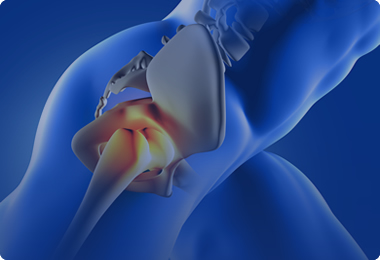Joint Replacement for Hip
Our Clinic Service for

Joint Replacement for Hip
Basic Anatomy:
A painful hip can severely affect your ability to lead a full and active life. Over the last twenty five years, major advancements in hip replacement have improved the outcome of this very common surgery greatly.
The hip joint is one of the true ball and socket joints of the body. The hip socket is called the acetabulum and actually forms a deep cup that surrounds the ball of the upper thigh bone or femoral head. The hip is surrounded by the thick muscles of the buttock at the back and the thick muscles of the thigh in the front. The surface of the femoral head and the inside of the acetabulum are covered with articular cartilage. This material is about 1/4 of an inch thick in most large joints. The articular cartilage surface is a tough, very slick material that allows the surfaces to slide against one another without damage to either surface.
Object (goal) of Hip Replacement:
The goals of hip replacement surgery are to improve function and mobility and to relieve pain.
Indication of Hip disorders:
- Avascular necrosis (loss of bone caused by insufficient
blood supply) - Rheumatoid Arthritis (a chronic inflammatory disease
that causes joint pain, stiffness, and swelling) - Osteoarthritis
- Traumatic injury
- Bone tumors
- Fractures
- Childhood defects
As a result of these conditions, a patient may undergo, hip replacement, or arthroplasty, a surgical procedure in which the diseased parts of the hip joints are removed and replaced with new, artificial parts.
Precautions after Hip Replacement Surgery:
- Avoid excessive bending (more than a 90º angle).
- Avoid excessive bending (more than a 90º angle).
- Avoid excessive twisting at the hips.
- Avoid rolling the leg inward or outward.
- Sleep with a special hip-separator pillow.
While knee joint problems are usually found on people at old age, hip joint problems are more common in youngsters, mainly due to their very active and fast paced life. Hence, independence in movement is very much important, considering their age, active life, social, family and above all personal life and all these factors should be taken into consideration while replacing the hip joints.
Can a patient sit with his legs crossed after the hip replacement surgery?
Certainly YES. As normal as one was earlier before the hip joint problems.
Hip joint replacement surgery is also as successful and long lasting as the Knee replacement surgery.
The life span of a replaced hip joint may be anywhere between 15 to 20 years. As the patients are normally of younger age a joint Revision surgery may become necessary. The future and life of a revised hip joint surgery is also as good as the first replacement.

